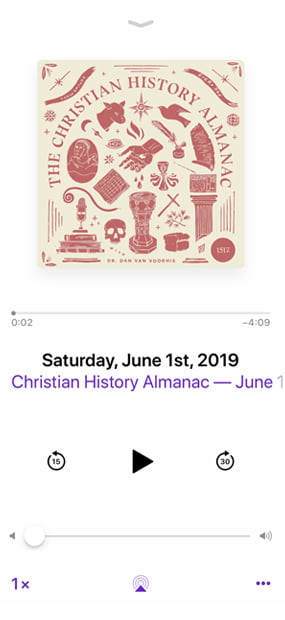Tuesday, October 21, 2025
Today on the Christian History Almanac, we remember a giant in the field of Biblical Archaeology.
It is the 21st of October 2025. Welcome to the Christian History Almanac, brought to you by 1517 at 1517.org; I’m Dan van Voorhis.
Let’s talk Biblical Archaeology! It is perhaps one of the more under appreciated stories in 20th century church history. And I get it… we have great migration of the faith from the Western world to the East and Global South. In the West we have the Fundamentalist-Modernist debates and the great denominational schisms, not to mention the Nazi’s and the rise of the atheist USSR and it’s effects on the church.
But it was also the golden age of biblical archaeology- we’ve told the story of William Foxwell Albright (link in the unofficial transcript at 1517.org https://www.1517.org/podcast-overview/2024-09-19). We should note the distinct shift from a kind of “treasure hunting model” developed out of the early church and a quixotic search for relics gave way to a more scientific approach. We can’t ignore the significance of the British Mandate in Palestine following World War I that opened that part of the world to foreign scholars. Approaches that included ceramics and stratigraphy (that is, the study of strata, or layers, of remains and its relationship to geology) helped to legitimize the field and the crown jewel in Near Eastern Studies was, perhaps, the discovery and legitimization of the Dead Sea Scrolls.
And anyone involved in this study is likely to find their way, at some point to the Kelso Museum of Near Eastern Archaeology at Pittsburgh Theological Seminary- named for a giant in the field and a colleague of Albright. He was James Leon Kelso, born on this, the 21st of October in 1892 in Duluth, Minnesota born to Bertha and Evan- they would move to Idaho and the Portland where the young James would develop his love of the Scriptures and desire to study theology. Graduating Portland High School in 1912 he then attended Monmouth College in Illinois before attending Xenia Theological Seminary in Ohio receiving his M.Div and Th.M by 1918. Xenia would move to St. Louis before merging with Western Seminary and Pittsburgh Seminary to become today’s Pittsburgh Theological Seminary serving the Presbyterian Church U.S.A.
Before becoming a seminary professor Kelso would serve as parish in Indiana where he also earned a masters and then began work on a PhD in the Classics from the University of Indiana at Bloomington (shout out to the #2 ranked Hoosiers). In 1923 he was called to the Seminary, still in St. Louis, and would move with it to Pittsburgh in 1930.
Kelso’s initial excavations came in the late 1920s with his mentor Melvin Kyle and and Albright at Tell Beit Mirsim- a site crucial in constructing the history of the kingdom of Judah. Kelso would gain recognition in the 1950s with his discovery of the ancient site of Bethel- where Abram is said to have built an altar and Jacob had his ladder dream.
While he would lead excavations for some 40 years he was also a favorite, if not eccentric seminary professor. In a collection of essays written in celebration of Kelso the opening essay begins: “This book is dedicated to one of the most unusual men in American theological education in the mid-Twentieth century”. He had a distaste for “pagan greek logic” and “systematic theology” but had a soft spot for students who were slow learners. The same essay notes his “deep and personal concern” for “slow learners” and those with a “inbred phobia of foreign, especially dead, languages”. HIs eccentric testing methods (he preferred simple, usually one word answer to his exam questions) were balanced by his “101st” question on the exam- the last that let the student write about anything else they learned that they couldn’t yet exhibit on the exam.
His popular publications included “An Archaeologist Looks at the Gospels” and “An Archaeologist Follows the Apostle Paul”. The revolution in biblical archaeology, which he helped to initiate would make some of his (and Albright’s) findings questioned in the last few decades- but their strides in turning the field from a glorified treasure and relics hunt into a distinguished academic field can’t be underestimated. James Leon Kelso would die in 1978, survived by his wife Adolphina. Born in 1892 he was 85 years old.
The Last word for today comes from the daily lectionary and James 5:
7 Be patient, then, brothers and sisters, until the Lord’s coming. See how the farmer waits for the land to yield its valuable crop, patiently waiting for the autumn and spring rains. 8 You too, be patient and stand firm, because the Lord’s coming is near. 9 Don’t grumble against one another, brothers and sisters, or you will be judged. The Judge is standing at the door!
10 Brothers and sisters, as an example of patience in the face of suffering, take the prophets who spoke in the name of the Lord. 11 As you know, we count as blessed those who have persevered. You have heard of Job’s perseverance and have seen what the Lord finally brought about. The Lord is full of compassion and mercy.
This has been the Christian History Almanac for the 21st of October 2025 brought to you by 1517 at 1517.org.
The show is produced by a man who notes that “Adolphina” really dropped off as a popular name sometime around last century… he is Christopher Gillespie.
The show is written and read by a man who knows that “Xenia” with an X, isn’t a Princess Warrior but a word for hospitality to strangers… I’m Dan van Voorhis.
You can catch us here every day- and remember that the rumors of grace, forgiveness, and the redemption of all things are true…. Everything is going to be ok.

Subscribe to the Christian History Almanac
Subscribe (it’s free!) in your favorite podcast app.